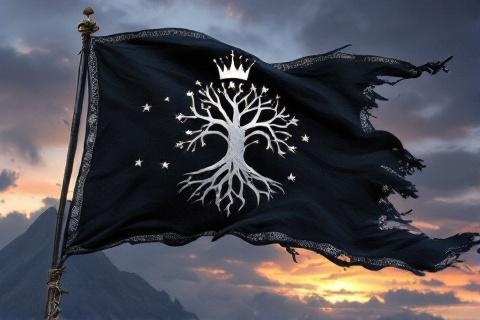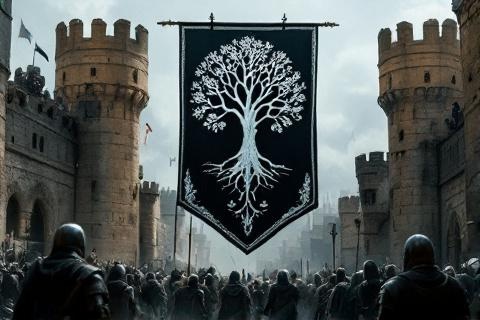
Banner of Elendil: The Starry Standard
The Heraldic Banner Unfurled at the Black Gate
Origins of the Royal Standard
The Banner of Elendil was first crafted in the closing days of
Númenor, as Elendil the Tall and his followers prepared to
flee the doomed island kingdom. This noble standard was created specifically for
Elendil as he led the Faithful across the Great Sea in their nine ships, serving
as a symbol of hope during their perilous journey to
Middle-earth.
Upon reaching the shores of Middle-earth, the Banner became the supreme symbol
of the newly established Realms in Exile: Arnor in the North and
Gondor in the South. As the first High King of both realms,
Elendil used this standard to unite his people and establish a new beginning for
the Númenóreans in Middle-earth.
The Banner carried profound significance as it represented the unbroken lineage
of the Kings from Númenor, stretching back to Elros Tar-Minyatur, first King of
Númenor and brother of Elrond. This heritage was particularly important as it
connected the Dúnedain to their noble ancestry and their special relationship
with the Valar and the Elves.
Symbolic Elements and Design

The Banner's black field represented the vast night sky of Middle-earth,
continuing a tradition from Númenor where astronomical symbols held great
significance. This deep background served as a striking canvas that enhanced the
visibility of the banner's other elements while symbolizing the depth of space
and time.
At the center of the Banner stood the White
Tree, a representation of Nimloth the Fair,
which once grew in the King's Court in Númenor. This sacred tree traced its
lineage to Telperion of Valinor through Galathilion of
Tirion and the tree of Tol Eressëa, symbolizing the connection
between the Dúnedain and the Blessed Realm.
Above the White Tree shone seven stars crafted of silver and gems, representing
the seven ships of the Faithful that carried Elendil and his sons to
Middle-earth. These stars were arranged in a significant pattern that recalled
the constellation of Valacirca, the Sickle of the Valar.
Crowning the design was a high crown, symbolizing the supreme authority of the
King of the Realms in Exile. This crown represented not only royal power but
also the responsibility of stewardship over the peoples of Middle-earth, a duty
passed down through generations of kings.
Historical Significance
The Banner served as a powerful symbol of unity between the northern and
southern kingdoms of the Dúnedain, reminding both realms of their common
heritage and shared purpose. Even after the division of the kingdoms, the Banner
remained a testament to their original unity and the hope of eventual reunion.
Throughout the Dark Years, the Banner represented steadfast resistance against
Sauron's growing power. Its very existence challenged the
Dark Lord's claim to dominion over Middle-earth, as it represented the
legitimate authority of the Heirs of Elendil.
The Banner was carefully preserved through countless generations by the Heirs of
Isildur, passing from father to son along with the shards of
Narsil and other heirlooms of the House of Elendil. This
preservation ensured that the symbol of Númenórean kingship would endure until
the time of restoration.
Creation and Craftsmanship

The Banner was originally woven by the most skilled craftsmen of Númenor, who
employed techniques that would later be lost with the island's destruction.
Their masterful work created a standard of extraordinary beauty and durability,
capable of withstanding the tests of time.
The materials used in the Banner's creation came from the royal treasuries of
Númenor, including precious threads and gems that were saved from the drowning
of the island kingdom. These materials carried with them the blessing and craft
of Númenor at its height.
The Banner was specifically designed to endure through the ages of Middle-earth,
incorporating both physical durability and magical preservation in its creation.
The craftsmanship combined Númenórean technical skill with elven knowledge of
preservation, ensuring the standard would remain untarnished by time.
Role in the War of the Ring

In a moment of supreme significance, Aragorn
unfurled the ancient Banner before the Battle of the Morannon at the Black Gate
of Mordor. This act declared his kingship and challenged
Sauron's power directly, showing that the line of the Kings had endured and
returned to claim its rightful place.
During the final battle, the Banner served as a rallying point for the armies of
the West, inspiring hope in the hearts of Men, Elves, and
Dwarves who fought against the forces of Mordor. Its presence
reminded all who fought that day of the nobility of their cause and the heritage
they defended.
The display of the Banner at the Black Gate marked the formal return of the King
to Gondor, fulfilling ancient prophecies and bringing hope to the Free Peoples
of Middle-earth. Its appearance heralded the end of the Third
Age and the beginning of the restoration of the Realms in
Exile.
Preservation Through the Ages
For many generations, the Banner was kept safe in Rivendell under the protection
of Elrond, along with the other heirlooms of the House of Elendil. In this
refuge, it remained hidden from the Enemy while awaiting the time of its return
to glory.
The Banner received regular care from the skilled craftsmen of Rivendell, who
used their ancient knowledge to preserve its materials and maintain its
splendor. Their efforts ensured that when the time came for its return, it would
still shine as brightly as it did in the days of Elendil.
Throughout the Third Age, the Banner remained in Rivendell as a symbol of hope
for the eventual restoration of the kingdom. Its presence served as a reminder
of the ancient promise that the line of kings would one day return to reclaim
their heritage.
Legacy and Modern Display

After the War of the Ring, the Banner of Elendil became the Royal Standard of
the Reunited Kingdom under King Elessar. It flew proudly over Minas Tirith and
Annúminas, symbolizing the restoration of both Gondor and Arnor under a single
crown.
The Banner held a place of honor at all important ceremonies throughout the
Fourth Age, including coronations, festivals, and diplomatic
meetings. Its presence added solemnity and historical weight to these occasions,
connecting them to the grand heritage of Númenor.
The design of the Banner inspired numerous similar standards throughout the
restored kingdoms of Gondor and Arnor. Noble houses and cities created their own
banners incorporating elements of the royal standard, though none matched its
antiquity or significance.
